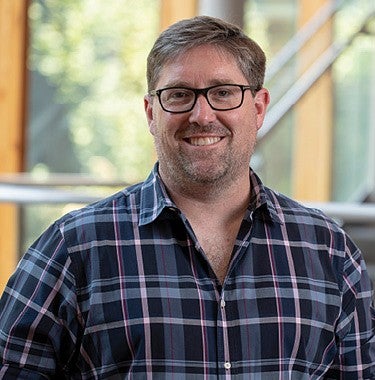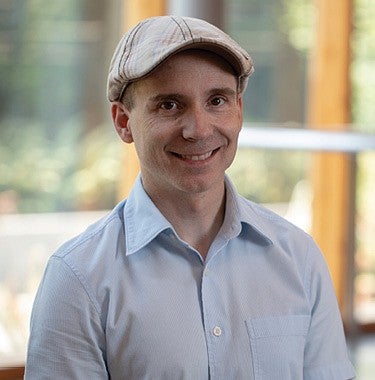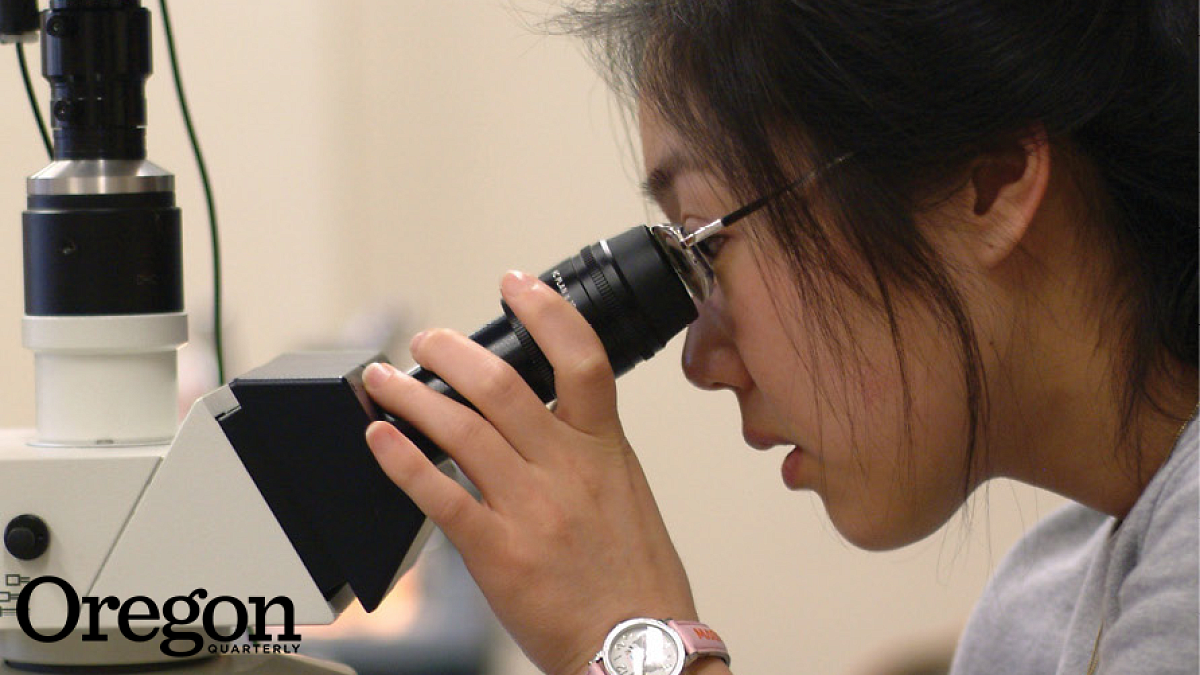The UO’s burgeoning undergraduate research program reflects the work of Josh Snodgrass, associate vice provost for undergraduate studies, and Kevin Hatfield, director of academic residential and research initiatives. They explained to OQ the role of undergraduate projects in student growth.
What is undergraduate research and why does it matter?
Josh Snodgrass: People hear “research” and they think microscopes and petri dishes, but it’s broader than that—it’s really just the creation of new knowledge. That could be the sciences, social sciences, arts, humanities, even the professional schools. It’s taking the skills undergraduates learn in class and applying them to a complicated problem or an unanswered question, adding something to a topic that interests them, or producing original work—a thesis or an experiment or even a piece of music.
Kevin Hatfield: Research creates flexible, independent thinkers—students who think outside of the box to solve problems. That’s what employers want, regardless of the major. Doing research teaches you to read critically, to analyze information. You learn to be patient and persistent.
It’s an especially effective way to teach, and undergrads who do research have a leg up for distinguished scholarships. They also develop relationships with faculty members and graduate students that help them get into graduate school or start careers.
What do you tell parents who believe their kids should focus on gaining technical skills?

The problems we need to solve in society are not easy ones, and they’re going to require students to apply themselves in situations they haven’t anticipated—to go above and beyond. That’s research.
Why does the University of Oregon prioritize undergraduate research?
KH: It’s what we do best as a research university. We’re engaging students in knowledge creation—this is different from a community college, from most small liberal-arts colleges. It’s different from the online degree environment. The data show that this type of “experiential learning”—learning by doing—is an especially effective way to work with course material.
What are some examples of undergraduate research?
JS: Check out the Undergraduate Research Symposium. This year we had more than 380 participants, and all eight undergraduate colleges were represented. As you’d expect, there were lots of projects in the natural sciences—biology, human physiology, environmental studies, students looking at climate change or cell structure. But we also had projects on dance and film, indigenous peoples, Greek life, jazz, space travel—even lemon meringue pie.
What’s the Undergraduate Research Symposium?
JS: The symposium is a daylong event at which undergraduates present their projects through poster or oral presentations and panel discussions. It’s a great way to get experience for a research conference and to connect with peers and faculty members. You learn how to talk about your work, how to answer questions.
Students are demanding undergraduate research opportunities because they see that as important to building their résumé and getting a job or getting into graduate school. The numbers at the symposium are clear: In the eight years we’ve run it, the number of presentations and student presenters has increased fivefold. This year, we had 310 presentations and 382 student presenters.
How does an undergraduate start in research?
JS: Reach out to a professor working on something you find interesting. If that doesn’t work, or if you’re uncomfortable doing so, contact the Center for Undergraduate Research and Engagement. The center can connect you to research opportunities, provide funding support, and help you showcase your work on campus or even across the state and nation.
KH: Another great way for first-year students to get their feet wet is with the ARCs—academic residential communities. These communities are a proven approach for student success, such as grade point average, retention, and graduating on time. They build a sense of belonging—it’s like an academic family, which is especially important at a large university.
Students in the ARCs live and take classes together on a topic of shared interest—music, social activism, Native American and indigenous studies, LGBTQIA+, or media and social action, to name a few.

Kevin, I know you’re excited about the work done by students to interview Native Americans. What’s the project?
KH: Students in the Native American and Indigenous Studies ARC live together in Kalapuya Ilihi Hall and take classes together, including a yearlong seminar in which they learn what research is and work on actual projects.
One of the recent projects was the “Indigenous UO” digital map. Students selected more than 20 sites on campus that are associated with Native American history and culture—location of the first UO Longhouse, for example. Each student takes a different site and does a mini–research project to provide information about that site—they get information from UO Libraries’ archives, they talk to tribal elders and community members and others who are involved in the ARC project. Then they write a two-page narrative for that spot.
That information was transferred to a digital format. Now, when you take a tour of campus, you can see on your phone the spots that have more information that can be accessed about the Native American experience. It’s interactive—and soon you can listen to an oral interview.
All of the ARCs have a project like that. It demystifies the whole process of doing research and it sets up students to work with faculty members in the future.
Same question, Josh—do you have a favorite undergraduate research story?
JS: Sandra Dorning (BS ’17, marine biology). She did a number of projects at the Oregon Institute of Marine Biology—everything from whales to threatened ecosystems. She did a project on a “sea squirt” species threatening an estuary in the Coos River.
Sandra went on to win a Marshall Scholarship (as many as 40 young Americans receive the scholarship annually to pursue graduate degrees free in the United Kingdom). When she applied for the scholarship, she had a track record of doing research and letters of recommendation from people in her corner, helping her with her application.
The people who are going to be competitive for these types of scholarships are the ones who have been deeply engaged in undergraduate research.
—By Matt Cooper, University Communications


